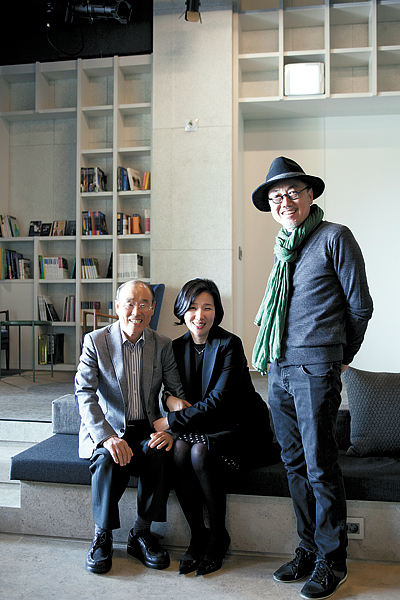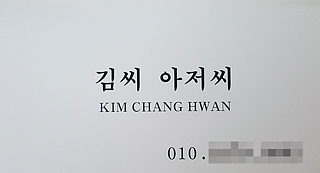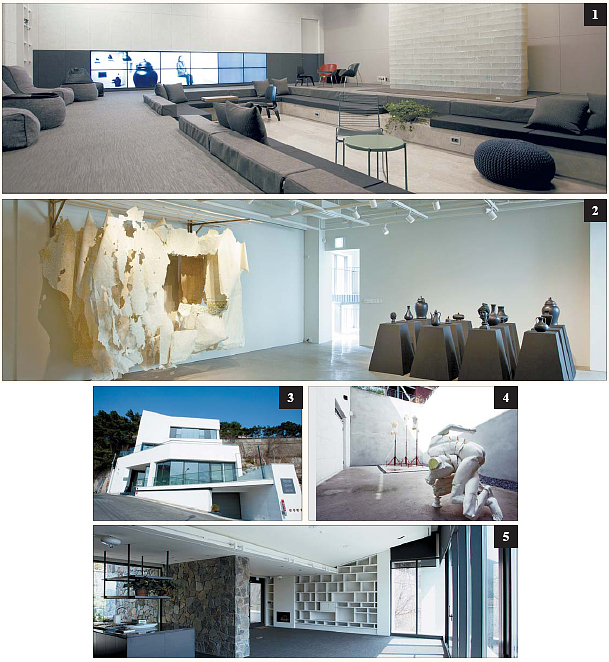A dream home built to nurture the arts : Constructed in secret, Sueno 339 is a space for creatives to grow

Kim Chang-hwan, left, recently opened the cultural space, Sueno 339, which aims to provide space for young artists. Kim asked Korean architect Choi Si-young, right, to design the facility which sits in the space of his old home in Pyeongchang-dong, central Seoul. Kim’s daughter Eun-joo, center, helps operate Sueno 339 by running a cafe inside the new space. [JEON HO-SUNG]
Architect Choi Si-young, of Living Axis said he was taken aback when the owner visited him with the project.
“I asked his name but he said, just call me Kim-ssi ajussi (a Korean word referring to a middle aged man).” said Choi.
Noticing the confused face of Choi, the owner handed him his name card and it really had “Kim-ssi ajussi,” which can be translated as “Mr. Kim” in English, in bold letters. Underneath it, in smaller fonts, it reveals his real name, Kim Chang-hwan, and his phone number.

Kim hesitates to reveal what exactly he does, and his business card only says “Mr. Kim.” [JEON HO-SUNG]
Wondering what this man was up to, the JoongAng Sunday met Kim early this month for an interview at Sueno 339, which was holding its second exhibition. Until the construction workers began their work, Kim said his family didn’t know anything about it.
“It was planned secretly behind their backs,” said Kim. After finding out about it, Kim said his wife scolded him saying that he should’ve bought a house with the money.
“My philosophy is to always think I’m at the bottom, without quibbling over what I do or who I am. I lived all my life modestly - just a good petit bourgeois,” said Kim, explaining why he introduces himself as Mr. Kim to others. “Because I have nothing to boast about, I just want people to call me Mr. Kim. Rather than living a life of hierarchy, I wanted to live horizontally. Rather than enjoying service and treatment, I want to serve others.“
Kim says he was born in Jongno district, and that he wanted to “leave behind a legacy for my descendants here in my birthplace.”
“I wanted to create a space, that can be used as a gathering place for my children, and their children,” he said.
Moreover, it has always been in the back of Kim’s head to create a space for young artists.
“As civilization progressed, the world became a more convenient place to live in. But the polarization became more serious and more people are living life below the average. I want Sueno 339 to serve these people. So for young people, I want it to act as a platform of opportunities,” Kim said. “Currently, the world, or this country, focuses not on nurturing talented young people, or young people with potential, but rather make their own teams. It really concerns me as to think about what kind of world my grandchildren will live in. People around me told me that I shouldn’t start Sueno 339 by renting the space out to just anyone as it has ‘class.’ But I opened it to everyone. I hope it can be open to those who really need it. It’s my dream to live a life dedicated to helping others.”

1. Sculptor Shin Mi-kyung’s work “The Wall,” which was made using soap, is currently being exhibited on the ground floor of Sueno 339. 2. Artist Yeon Gi-baek’s “Garibong 133,” left, and Shin’s “Archetype Series,” right. 3. The exterior of Sueno 339 located on a slope in Pyeongchang-dong, central Seoul. It opened in February. 4. Artist Lee Byung-ho’s “Two Figures,” front, and “Triptych,” back exhibited at the outdoor terrace. 5. The top floor of Sueno 339. [JEON HO-SUNG]
“Maybe in 10 to 20 years, the artists who have performed or exhibited their works here can walk past Sueno 339 and reminisce saying, ‘I showcased my work here many years back and it helped me to be where I am today,’” said Kim. “I am not rich enough that I can splurge but I thought that if I could sacrifice a little, I can build a space that’s productive. That’s what I’m investing in.”
Kim even kept the project from his wife and children as he didn’t want to get into squabbles from the start “for doing what I must do.”
Kim’s youngest daughter Kim Eun-joo, 43, said they were shocked after learning what their father had been doing behind their back.
“I was surprised that he even had the money to start this,” she said, explaining how frugal Kim has been.
“The house was always quite cold during winter as we weren’t allowed to turn up the heater and our socks had to be worn until it was impossible to wear inside a shoe,” she added. “I can talk about it all day.”
To help his father fulfil his life-long dream, Kim’s daughters came together to operate Sueno 339. Eun-joo was busy taking care of her child who’s preparing for the college entrance exam this year, but she rolled up her sleeves and decided to help her father by operating a cafe inside Sueno 339. This kind of business was all new to Kim’s family, who said their goal is to at least keep the space running.
Concerned about Kim’s new building, the neighbors have been giving Kim advice such as putting a sign on the house to at least let people know that the space exists. Sueno means “dream” in Spanish and Kim says he wants to help young Koreans build their dreams while providing a “time to rest” for residents.
“In a society where economic value is considered the most important thing, this space may be seen as inefficient,” said Eun-joo. “But we hope that people living in the society are not swayed by economic value alone. We hope this space can become a place that’s all about sharing.”
Using the slope of the land in Pyeongchang-dong, architect Choi came up with two extra floors for Sueno 339. The ground floor, houses a cafe and a multi-purpose hall. By opening up a sliding wall between the cafe and the hall, the whole floor can be used as one space. Instead of installing a stage, Sueno 339 has a rectangular area that’s been hollowed out about 45 centimeters (17.7 inches) from the ground.
“This space can be used as a stage or an auditorium,” said Choi. “After seeing this ‘stage slash auditorium,’ actor Park Sang-won said he wants to hold a one-man show here.”
When there is no scheduled performance or exhibitions, Choi said this can be used like stairs where people who visit the cafe can sit and rest.
Excluding the parking area, heated flooring has been installed on all floors so that people can sit down anywhere they want to watch performances or enjoy artwork. Of course, it made Kim’s wallet thinner, but Kim said he doesn’t think much after making a decision to do something.
“All I care about is that the space can play its role properly,” said Kim.
After the official opening, Sueno 339 hosted two cultural events - an art exhibition followed by a concert by classic guitarist Hwang Min-woong. Currently, the space is holding another art exhibition showcasing various artists including Kim Seo-yeon, Shin Mi-kyung, Yeon Gi-baek and Lee Byung-ho. Sculptor Shin’s work “The Wall” which was exhibited at the Asia Culture Center in Gwangju is currently on display. Shin is known for using soaps to recreate ancient remains. Yeon’s sculpture “Garibong 133” will also catch visitors’ eye. The main material used in this artwork is old wallpaper that was used in a residential building where female factory workers had once lived in the 1970s and 80s in Garibong-dong in Guro district, western Seoul.
BY HAN EUN-HWA [sharon@joongang.co.kr]
The current exhibition is open to all for free and runs until May 31. The building is open from 11 a.m. until 7:30 p.m. everyday except for Mondays. For more information on exhibitions or Sueno 339, call (02) 379-2970 or visit www.sueno339.com.
소시민 김씨 아저씨, 청년 위한 사랑방 만들다
집 한 채 새로 짓는 데 2년이 걸렸다. 공사기간만 따져서다. 서울 평창동 기슭에 자리한 터(대지면적 453㎡)의 암반을 드릴로 뚫고 다지는데만 8개월을 썼다. ‘대체 어떤 건물이기에 저렇게 공들여 공사할까’ ‘수익형 원룸 건물이겠지’…. 동네 사람들의 이목이 집중됐다. 지난 2월 집의 오픈식이 열렸다. 초대글에 담긴 사연이 이랬다.
“평창길 339는 삶의 터전이었습니다. 일상의 흔적들을 남기며 한 가족이 20년 넘는 세월을 보낸 곳이었습니다. 이제 평창길 339는 ‘수애뇨(sueno)339’로 거듭납니다. 다양한 예술을 만나고 체험하며 조금 더 풍성한 세상으로 이어지는 터전이 되는 꿈을 꾸어봅니다.”
평창동에 전시ㆍ공연ㆍ음악 등 모든 장르를 담아내길 꿈꾸는 복합문화공간이 들어섰다. 건물을 설계한 건축가 최시영(리빙엑시스 대표)은 “처음 건축주를 만나 성함을 여쭤봤을 때 당황했다”고 전했다. 연세 지긋한 건축주의 대답이 범상치 않았기 때문이다. “그냥 김씨 아저씨라고 불러주세요.”
‘농담일까, 진담일까….’ 반신반의하는 최 대표에게 건축주가 명함을 건넸다. 흰 명함에는 이름과 전화번호만 달랑 적혀 있었다. 회사명도 직함도 없다. 그리고 ‘김씨 아저씨’가 커다랗게 적혀 있었다.
김씨 아저씨, 김창환(78) 수애뇨 대표는 20년간 살아온 집을 허물고, 문화공간을 만들고 싶다고 방문목적을 밝혔다. 그리고 “내세울 것 없이 골고루 일 많이 한 사업가”라고 자신을 소개했다. 문화계 관련 일을 해왔던 것도 아니다. 다만 슬하에 둔 사남매 중 큰 딸과 막내 딸이 각각 피아노와 비올라를 전공했고, 둘째 딸이 스페인 문학을 공부했다고 했다. 돈 많은 사업가의 문화공헌 사업일까. 지난 7일 수애뇨의 두 번째 전시 ‘잔의 깊음’ 오픈식 날 김씨 아저씨를 만났다. 그는 “공사 들어가기 전까지 가족 몰래 벌린 일”이라며 “나중에 아내한테 ‘그 돈으로 집이나 사주지’라는 핀잔 많이 들었다”며 웃었다. 그는 지금 아파트 전세살이 중이다.
왜 ‘김씨 아저씨’라고 자신을 소개하나.
“직종ㆍ성별 따지지 않고 내가 제일 바닥이라고 생각하며 산다. 내 철학이다. 소시민으로 민초로 살아왔다. 명가에 내세울 게 아무 것도 없는 소시민이니까 그저 누가 부르던지 아저씨라고 부르면 돌아보니까 ‘김씨 아저씨’가 제일 편안하다. 수직보다 수평적으로 살고 싶다. 대접받는 것보다 섬기며 살고 싶달까. 어허허허.”
‘수애뇨’를 어떻게 만들게 됐나.
“출생지가 종로다. 출생지에 유업(遺業)을 남겼다면 좀 우스운지 모르겠지만…. 후손들의 사랑방이 됐으면 좋겠다. 비록 작은 공간이지만 하나의 초석이 됐으면 좋겠다. 10~20년 뒤 수애뇨를 거쳐간 이들이 지난날을 회상하며 ‘내가 그때 이런 공연을 했는데 집터가 좋았는지 내가 이만큼 컸어’라는 이야길 듣기 바란달까. 풍요로워서 돈 많이 쓸 형편은 아닌데, 내가 희생하면 장래 올바른 사랑방 역할을 하지 않을까 싶어 투자하는 거다.”
주위 반대는 없었나.
“‘당장 수익이 나는 일도 아닌데 노후자금으로 왜 이런 일을 하느냐’는 이야기는 우리 식구들한테 가장 먼저 들었다. 1989년 집을 사서 20년간 살았는데 집이 오래되고 집 안에 계단도 많아 아내가 힘들어 해서 이사했다. 그 터 위에 이 공간을 만들게 됐다. 가족 몰래 했다. 해야 할 일인데 하기 전부터 마음 안 맞아서 서로 불편할까봐, 내 평생이 그랬다.”
어떤 공간이 됐으면 하나.
“문명이 발달할수록 편리한 세상이 됐지만 계층 간 갈등이 심하고, 평균 이하로 사는 사람이 많아졌다. 수애뇨가 젊은 사람들에게 기회의 장이 됐으면 한다. 능력 있는 사람 키워주기보다 자기들만의 리그를 만들지 않나. 내 손자 세대의 장래가 걱정되는 일이다. 사람들이 공간의 격을 생각해 대관부터 하면 안 된다고 했는데 모두 열어놨다. 필요한 사람에게 열린 장소였으면, 도우면서 같이 가고 싶은 게 꿈이다.”
처음 수애뇨를 짓겠다는 김 대표의 이야기에 가족들은 모두 놀랐다고 입을 모았다. 막내 딸 은주(43)씨는 “우리 아버지한테 이런 돈이 있는 줄 지금껏 몰랐다”고 말했다. 아버지의 근검절약과 관련한 에피소드는 차고 넘쳤다.
“아버지가 귀가하기 전까지 보일러도 못 틀고, 양말은 늘 해질 정도로 신어야 하고…. 말로 다 못해요.”
하지만 이제는 “사람이 밥만 먹고 사는 것은 아니다”는 아버지의 뜻대로 딸들이 합심해 수애뇨를 꾸려나가고 애쓰고 있다. 전업주부였던 막내 딸은 고3 수험생 자녀를 두고서도 카페 운영에 뛰어들었다. 가족 모두에게 서툰 일이지만 “일단 버티는 게 목표”라고 했다. 애쓰는 마음이 닿았을까. 지나가던 동네 주민이 일부러 들어와 “간판을 달아야 사람이 온다”며 조언하기도 한다.
수애뇨는 스페인어로 ‘꿈과 쉼’을 뜻한다. 문화예술계 청년들에게 꿈을, 동네 주민들에게 쉼을 주는 장소가 됐으면 하는 바람을 담았다. 2월 첫 전시를 오픈할 때 딸은 가족을 대표해 인사말을 했다.
”경제적인 가치가 중요한 사회에서 이 선택은 너무 비효율적일지 모르겠습니다. 그런데 경제적인 가치에만 휘둘리지 않았으면 좋겠습니다. 나눌 수 있는 터가 됐으면 합니다.”
“누구든 욕심나서 뭐든 하고 싶어지는 공간 됐으면”
수애뇨는 4층 같은 2층 집이다. 평창동의 경사지를 활용해 지하 같지 않은 2개 층을 얻었다. 1층(실제로 지하 1층)은 카페와 다목적공간을 겸한다. 카페의 한쪽 벽을 밀어 열면 공간이 하나로 이어진다. 수애뇨는 공연도 전시도 할 수 있는 복합문화공간을 지향하지만, 무대가 없다. 대신 1층 한 가운데 바닥면보다 45㎝ 가량 파인 직사각형 공간이 있다. 공간을 디자인한 최 대표는 “배우에게는 무대가 될 수도, 관객에게는 객석이 될 수 있는 공간”이라며 “배우 박상원이 수애뇨의 1층 공간을 보고서 ‘여기서 독백극을 하고 싶다’며 인상깊어 하더라”고 덧붙였다.
공연이 없는 날에는 카페 손님이 직사각형의 계단참에 앉아 쉴 수 있게 할 계획이다. 최 대표는 “컨셉트를 정하고 공간을 꾸미기보다, 공간을 보고 컨셉트를 정하고욕심나서 뭐든 하고 싶어지게 하는, ‘스페이스텔링’을 떠올리며 디자인했다”고 설명했다.
누구나 털썩 주저 앉아 관람할 수 있게 주차공간을 제외하고 전 층에 바닥 난방을 했다. 돈이 더 들었을 터다. 김씨 아저씨는 “마음 먹으면 다음 생각을 안 한다. 건물이 여러가지 역할을 했으면 좋겠다는 마음 뿐이다”고 말했다.
수애뇨는 개관전 ‘터.위.꿈’을 거쳐, 클래식 기타리스트 황민웅의 공연을 했고, 현재 두 번째 기획전 ‘잔의 깊음’이 열리고 있다. 다음달 31일까지다. ‘남겨진 것의 장엄’이란 부제로 작가 김서연, 신미경, 연기백, 이병호가 참여했다. 광주아시아문화전당에 설치됐던 신미경 작가의 ‘더 월(The Wall)’을 다시 볼 수 있다. 그는 비누로 다양한 동서양의 고대유물을 재현하는 조각가다. 고대유적을 비누로 만들어 화장실에 놓고서 관객이 손 씻게 하는 ‘화장실 시리즈’ 등이 유명하다.
연기백 작가의 ‘가리봉 133’도 시선을 끈다. 지금은 재개발 되고 없어진, 한 때 70~80년대 여공들이 살던 연립주택의 도배지를 전시했다. 이상윤 전시기획자는 “어떤 집은 덧붙여 바른 벽지만 13겹이 나왔다고 하더라”며 “공간이 없어지고 기능이 상실하면서 가치를 잃었다고 여겨진 벽지지만 전시장에서 봤을 때 깊은 세월의 장엄함이 느껴지는 작품”이라고 설명했다. 전시는 무료다. 02-379-2970
한은화 기자










with the Korea JoongAng Daily
To write comments, please log in to one of the accounts.
Standards Board Policy (0/250자)